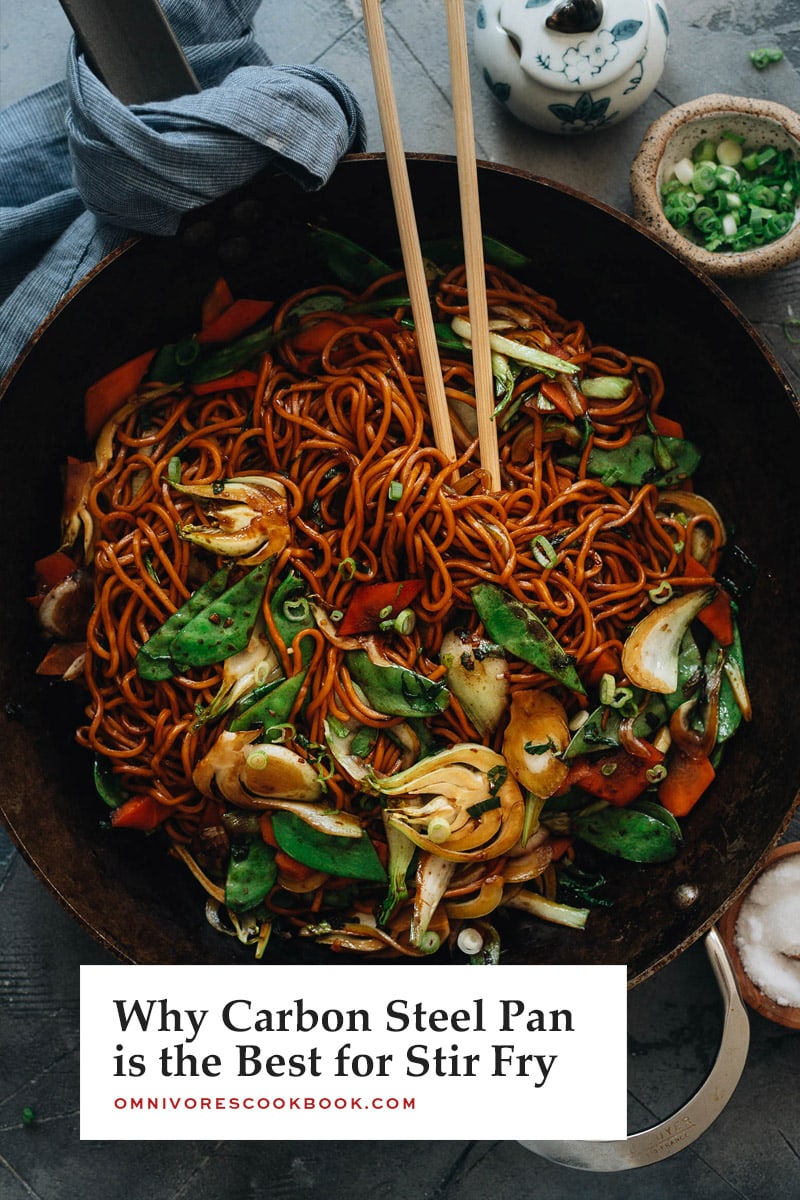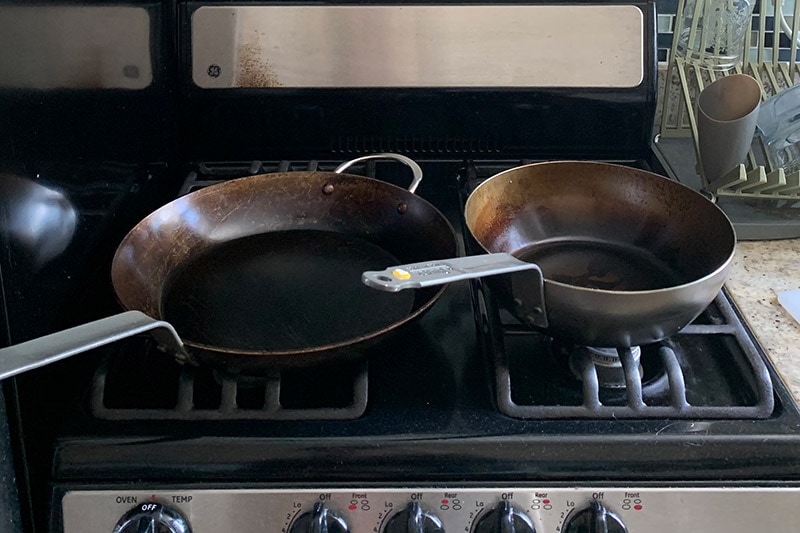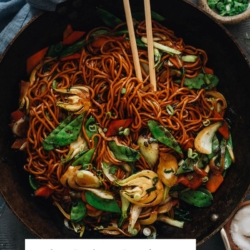If you’re looking for a great stir fry pan that performs well in a home kitchen, this is the place to start.

Over the years I’ve cooked in different home kitchens using different stoves and equipment. After many experiments and comparisons, carbon steel pans have become one of my essential pieces of equipment, and it’s the pan I use most frequently, almost daily. I covered in a previous post why you shouldn’t use a wok, and the best stir fry equipment depending on your kitchen setup. Long story short, I choose to use carbon steel pans because they’re suitable for most home kitchens, where you have limited space and a stove that’s not as powerful as in a commercial kitchen.
If you’re looking for a pan that cooks great Chinese food (and other types of food!), and will last forever, a carbon steel pan is your best bet.
Why carbon steel pan
Carbon steel pan vs nonstick pan
Nonstick pans have a chemical coating that will dissolve when the pan gets too hot and pose a potential health hazard. Chinese stir fry requires heating up the pan very hot most of the time, which makes a carbon steel pan a safer choice since it’s made from just metal. Carbon steel pans also hold heat better and thus sear food better than nonstick.
Carbon steel pan vs cast iron pan
Both require similar care and both are low-stick (and close to nonstick when well-seasoned). However, a carbon steel pan is slightly lighter and easier to handle, and cooks the food just as well. And the sloped side construction is more suitable for stir frying.
Carbon steel pan vs wok
A round-bottom wok requires a wok ring, which creates a wide gap with the stove and thus does not heat up well.
A carbon steel pan has a larger contact surface with the stove, which means you’ll be able to heat up your pan better on an electric stove. It’s also more stackable and takes up much less space than a wok.
Also, if you choose a taller carbon steel pan, it can actually function like a wok with a flat bottom.
Other advantages
- A carbon steel pan is low-stick once seasoned, and quite non-stick for most types of food after you’ve used it for a while.
- It retains heat well and cooks better food, especially in a home kitchen where the stove is not as powerful as a commercial stove.
- If you know how to take care of your pan, it will last forever. So you’ll be spending much less money on cooking equipment rather than buying a new nonstick pan every few years.
Things to note before purchasing a carbon steel pan
- Carbon steel pans are quite heavy to handle. A 12” carbon steel skillet is just under 6 lbs, while a 12” nonstick is about 3 lbs. Though it’s still lighter than a 12” cast iron pan, which is around 7 lbs.
- A slightly steeper learning curve that requires some getting used to. Your food might stick to the pan at the beginning, but things will get better.
- You will need to use a bit more oil (than if you were using a nonstick pan) to cook food properly.
- It takes some aftercare whenever you use the pan, but it’s super easy and you’ll get used to it in no time.
My recommendation

Debuyer 12.5” Mineral Fry Pan or 11″ Mineral Pro
It’s a great pan for making Chinese stir fries, noodles, shallow frying, searing food (like steaks), and almost everything else. I like the large surface which allows you to heat it up thoroughly, whether you’re using a gas stove or an electric one. Most of the stir fry recipes on my website are suitable for cooking in this pan. The 11″ Mineral Pro has a upgraded handle so you can use the pan in the oven as well.
The downside of this pan is its weight. It’s 5.79 lbs, a bit heavy to handle if you’re short like me (I’m 5’2”).
You might worry that the pan is quite shallow and food might spill all over the stove. But it won’t once you’ve gotten used to the cooking style – let the food sear, flip and stir the food less frequently, and use a pair of tongs to toss the food, so it won’t cause a mess.
Debuyer 11” Country Chef Fry Pan
This might be the best wok replacement because it’s shaped like a wok with a flat bottom. It has tall sloped sides that make it perfect for tossing and stir frying.
I recommend this pan only if you use a slightly more powerful gas stove (e.g. heat output – 12000BTU/hr). The bottom surface is smaller than the 12.5” pan, so it will heat up slower on an electric stove or on a weaker gas stove (like the one in my current apartment).
It’s around 5.5 lbs, a bit lighter than the 12.5” frying pan. However, its shape makes it quite awkward to handle when you wash the pan. It also takes up more space. After moving from Austin to New York, I swapped it for a Debuyer 9” Country Chef Frying Pan.
Debuyer 9” Country Chef Fry Pan
This pan is like a mini wok and weighs only 4.18 lbs. I like to use it for making simple stir fried veggie dishes and for deep frying. It’s a good size to have if you only need to cook for one or two people. And it’s also great for making simpler dishes that contain less ingredients because it’s quite light and easy to handle.
Other great carbon steel pan brands
Matfer Bourgeat is another reputable brand recommended by America’s Test Kitchen. I’ve never used it personally but a friend told me it’s very similar to Debuyer. The Matfer carbon steel pan is slightly lighter. Their 12.5” pan is 5.3 lbs and thinner than the Debuyer.
Other equipment you might need
Cleaning Brush
A cleaning brush designed for cast iron/wok is a must-have to pair with your carbon steel pan. I will talk about carbon steel pan care in another post, but long story short, you will need a brush that can sustain heat, is tough enough to clean off any food residue, but is not so tough that it scrapes off the pan seasoning. I found a wok brush to be perfect for this purpose.
Wok turner & tongs
A wok turner and a pair of tongs are also essential for making stir fries.
Unlike the wood and silicone spatulas that are popular in Western kitchens, the Asian style wok spatula has a sharper edge and lopsided design that helps flip the food and makes it easier to transfer food to a plate.
A pair of tongs is also important, especially if you like making fried noodles. The tongs will enable you to toss the noodles well without spilling food everywhere.
The next step
Once you get your carbon steel pan, the first step is to season it. You’ll also need to take proper care of the pan, which will improve its performance and make it last forever. Read How to Season a Carbon Steel Pan.
Want to learn more about Chinese Cooking? Sign up my newsletter to receive the 5-Day Chinese Cooking Crash Course and recipe update!














How about Carbon Steel vs Stainless Steel?
Good point! Stainless steel pan is perfect for searing protein, cook veggies and sauces, but starchy food will stick to it like hell.
Most Chinese stir fries (with proteins) uses a cornstarch slurry to coat the meat (and other proteins) to keep the meat tender during cooking on high temperature pan. The starch will stick to a pan easily. Also if you cook fried rice and noodles, they are quite tricky because they are super starchy.
I use stainless pot exclusively for boiling. I think it’s more suitable for western cooking, like searing a steak. Once the pan is heated, the meat will stick to the pan at first but release from it once browned (you cannot move it when it’s searing). Chinese cooking requires stirring, and it changes pan temperature when you add the ingredients in multiple steps, so the food can easily ended up sticking.
Thanks for the advice! I have a flat bottom/stainless wok… it is the only pan I have for one of my front burners to take all the heat… even on low. Like you said, it sticks like crazy. First I am going to try to carbonize the SS… don’t know if this will work. If not, then I will look for a flat bottom carbon steel wok.
I stay on a Keto diet because I am diabetic. Do you know of a replacement for corn starch that is low carb? Do you think Vital Wheat Gluten will work in place of corn starch?
I plan to try your salt/pepper pork chops soon but substitute something low carb for the corn starch.
Hi, I just was wondering. Will teriyaki sauce or other sauces strip the seasoning that has built up on my carbon steel pan?
Teriyaki and most sauces won’t strip the seasoning. Only the one with acid will. But even sauces like General Tso’s, since you mix in the sauce at the very end and it doesn’t stay in the pan for too long, it’s fine. Sauces like Pad Thai sauce can be tricky since it has high acidity and you need to cook the sauce for longer (mine was stripped when I made Pad Thai a few times in a row).